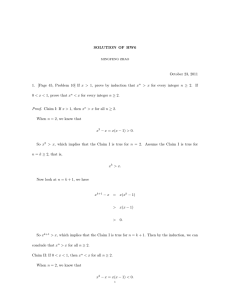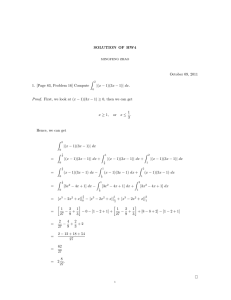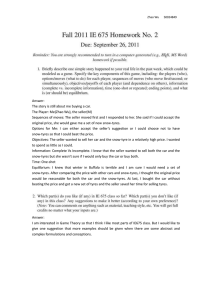SOLUTION OF TEST 4 December 07, 2012 1
advertisement
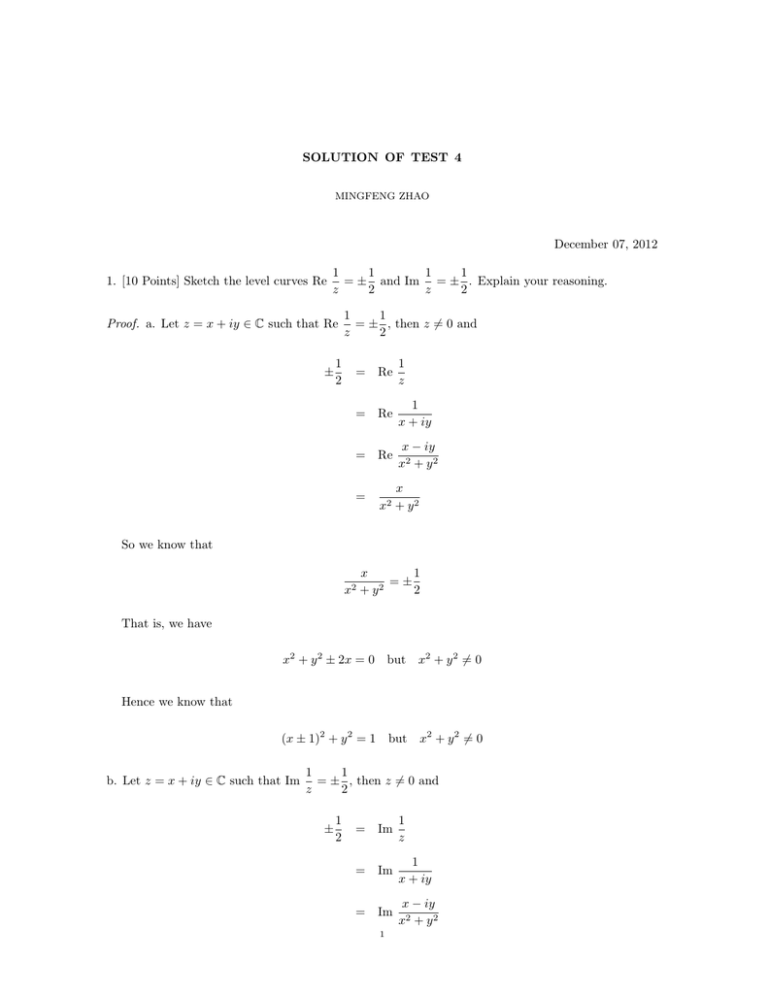
SOLUTION OF TEST 4 MINGFENG ZHAO December 07, 2012 1. [10 Points] Sketch the level curves Re 1 1 1 1 = ± and Im = ± . Explain your reasoning. z 2 z 2 Proof. a. Let z = x + iy ∈ C such that Re ± 1 2 1 1 = ± , then z 6= 0 and z 2 = Re 1 z = Re 1 x + iy = Re x − iy x2 + y 2 = x x2 + y 2 So we know that x2 1 x =± 2 +y 2 That is, we have x2 + y 2 ± 2x = 0 but x2 + y 2 6= 0 (x ± 1)2 + y 2 = 1 but x2 + y 2 6= 0 Hence we know that b. Let z = x + iy ∈ C such that Im 1 1 = ± , then z 6= 0 and z 2 ± 1 2 = Im 1 z = Im 1 x + iy = Im x − iy x2 + y 2 1 2 MINGFENG ZHAO = −y x2 + y 2 So we know that 1 −y =± 2 +y 2 x2 That is, we have x2 + y 2 ± 2y = 0 but x2 + y 2 6= 0 x2 + (y ± 1)2 = 1 but x2 + y 2 6= 0 Hence we know that SOLUTION OF TEST 4 3 2. [10 Points] Find a linear fractional transformation that maps the real axis onto itself and the imaginary axis onto the circle with center 2 and radius 2. Explain your reasoning. Proof. Let f (z) = 4z , then it easy to see that f (z) ∈ R for all z ∈ R. Also we know that z−2 f (0) = 0 and f (∞) = 4, since f is a linear fractional transformation, then f maps the imaginary axis onto a circle or straight line which must pass 0 and 4 and be perpendicular to the real axis, but f (i) = 4i 6∈ R, then f maps the imaginary axis onto the circle with center 2 and radius 2. i−2 4 MINGFENG ZHAO 3. [10 Points] Let f (z) = z2 . Find the maximum and minimum values of |f (z)| for |z| ≤ 1 and z−3 find all points z at which the max/min occur. Show all steps. Proof. Let g(t) = t2 for all 0 ≤ t ≤ 1, then t+3 g 0 (t) = 2t(t + 3) − t2 (t + 3)2 = t2 + 6t (t + 3)2 ≥0 Then g is increasing on [0, 1]. For all |z| ≤ 1, then 2 z |f (z)| = z − 3 = |z|2 |z − 3| ≤ |z|2 3 − |z| ≤ 1 3−1 1 2 2 z |f (z)| = z − 3 = = |z|2 |z − 3| ≥ |z|2 |z| + 3 ≤ 1 1+3 = 1 4 Since g(t) = t2 is increasing t+3 So we know that 1 1 ≤ |f (z)| ≤ , 4 2 ∀|z| ≤ 1 SOLUTION OF TEST 4 5 On the other hand, we know that f (1) f (−1) = 1 |3 − 1| = 1 2 = 1 | − 1 − 3| = 1 4 If |f (z)| = 12 , then we know that |z| = 1 and |z − 3| = 3 − |z| = 2. Hence z = 1. If |f (z) = 41 , then |z| = 1 and |z − 3| = 3 + |z| = 4. Hence z = −1. 6 MINGFENG ZHAO 4. [10 Points] Answer the same question for f (z) = Proof. Let g(t) = z3 . z2 − 3 t3 for all 0 ≤ t ≤ 1, then t2 + 3 g 0 (t) = 3t2 (t2 + 3) − t3 · 2t (t2 + 3)2 = t4 + 9t2 (t2 + 3)2 ≥0 Then g is increasing on [0, 1]. For all |z| ≤ 1, then |f (z)| = 3 z z2 − 3 = |z|3 |z 2 − 3| ≤ |z|3 3 − |z|2 ≤ 1 3−1 = |f (z)| = 1 2 3 z z2 − 3 = |z|3 |z 2 − 3| ≥ |z|3 |z|2 + 3 ≤ 1 1+3 = 1 4 Since g(t) = t2 t3 is increasing +3 So we know that 1 1 ≤ |f (z)| ≤ , 4 2 ∀|z| ≤ 1 SOLUTION OF TEST 4 7 On the other hand, we know that f (1) f (i) = 1 |3 − 1| = 1 2 = 1 | − 1 − 3| = 1 4 If |f (z)| = 12 , then |z| = 1 and |z 2 − 3| = 3 − |z|2 = 2. Hence z 2 = 1, which implies that z = ±1. If |f (z)| = 41 , then |z| = 1 and |z 2 − 3| = 3 + |z|2 = 4. Hence z 2 = −1, which implies that z = ±i. 8 MINGFENG ZHAO 5. [10 Points] Find the number of zeros of the polynomial z 4 + 4 that lie in the right half plane. Explain your reasoning. Proof. Since −4 = 4 · eiπ , then z1 = √ π 2ei 4 , z2 = √ π 2e−i 4 , z3 = √ 2ei 3π 4 , and z4 = √ 2e−i 3π 4 If z lies in the right half plane, then only z2 and z4 are our choices. Department of Mathematics, University of Connecticut, 196 Auditorium Road, Unit 3009, Storrs, CT 06269-3009 E-mail address: mingfeng.zhao@uconn.edu
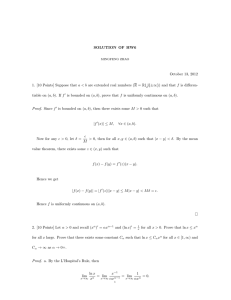
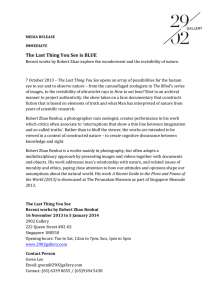
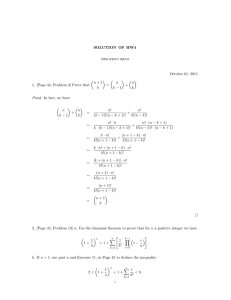
![SOLUTION OF HW3 September 24, 2012 1. [10 Points] Let {x](http://s2.studylib.net/store/data/011168953_1-36e45820ffc71e8ec27ae652a93485b4-300x300.png)

